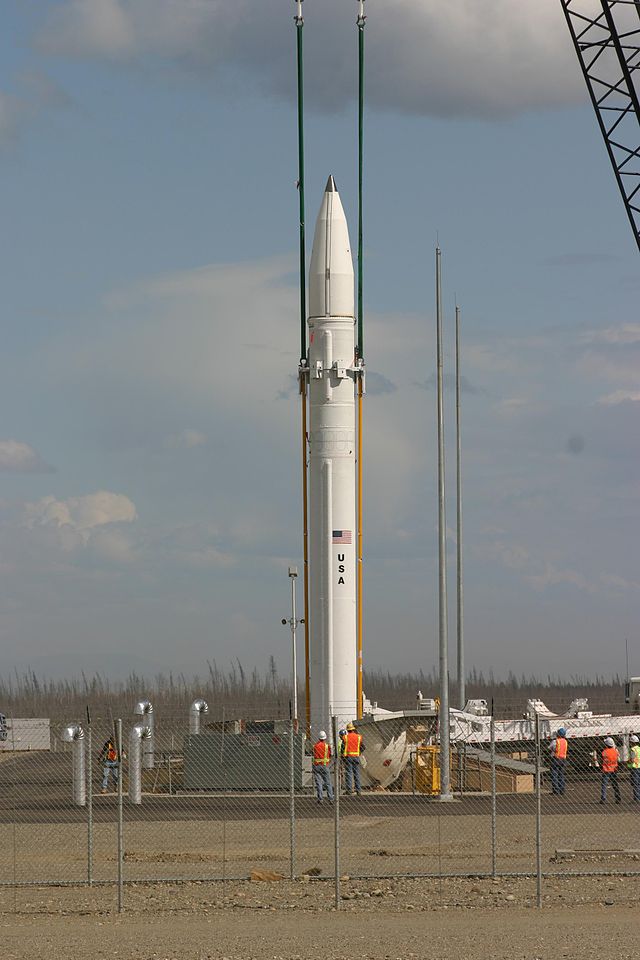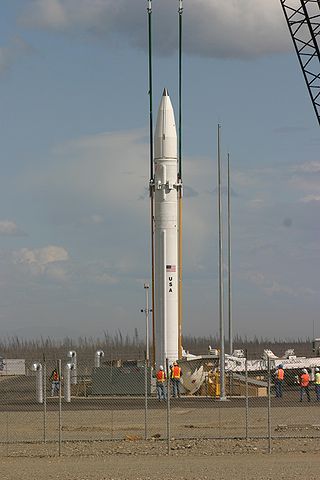Top Qs
Timeline
Chat
Perspective
Ground-Based Midcourse Defense
United States anti-ballistic missile system From Wikipedia, the free encyclopedia
Remove ads
Ground-Based Midcourse Defense (GMD), previously National Missile Defense (NMD), is an anti-ballistic missile system implemented by the United States of America for defense against ballistic missiles, during the midcourse phase of ballistic trajectory flight. It is a major component of the American missile defense strategy to counter ballistic missiles, including intercontinental ballistic missiles (ICBMs) carrying nuclear, chemical, biological or conventional warheads.[1]

As of 2018, the system is composed of two interceptor staging bases in the states of Alaska and California, with 40 staged in the former, 4 staged in the latter, for a total of 44 interceptors, as well as the component early warning and targeting sensors based on land, sea, and in orbit.[2][3] As of 2019, a Missile Defense Review has requested 20 additional interceptors to be based in Fort Greely, Alaska, though their delivery has not materialized.[4]
GMD is administered by the U.S. Missile Defense Agency (MDA), while operational control is provided by the U.S. Army, with support functions provided by the U.S. Air Force and U.S. Space Force.
Remove ads
Background
Summarize
Perspective
GMD after its renaming in 2002 remains a limited defense system, intended to protect the continental United States from limited launches of ballistic missiles.[5] Examples given in the past have included countries such as North Korea.[6]
GMD has undergone some controversy over its operational lifetime, such as with a study in 2000 by the Union of Concerned Scientists and the Security Studies Program at the Massachusetts Institute of Technology concluding that "[a]ny country capable of deploying a long-range missile would also be able to deploy countermeasures that would defeat the planned NMD system." Countermeasures studied in detail were bomblets containing biological or chemical agents, aluminized balloons to serve as decoys and to disguise warheads, and cooling warheads to reduce the kill vehicle's ability to detect them.[7] Currently, the Union of Concerned Scientists maintains that GMD is "unproven, unaccountable, and unhelpful for reducing the nuclear threat."[8]
More recently, questions have been asked about the Pentagon characterizing the January 28 test in 2016 as a success, when LA Times reported that the EKV suffered a fault in its reaction control system thrusters, which resulted in "a distance 20 times greater than what was expected" according to an anonymous Pentagon scientist.[9]
Under the Missile Defense Agency, GMD has conducted multiple test exercises, with mixed results. Early testing revealed deficiencies in the Ground Based Interceptor missile, as well as the Exoatmospheric Kill Vehicle. However, with time, success rates increased, marred by the occasional technical failure such as in 2010's FTG-06 (Flight Test Ground-Based Interceptor) where the Sea-based X Band Radar failed to perform as expected,[10] and the subsequent FTG-06a where despite all elements performing correctly, intercept failed to occur.[11]
Remove ads
Description
Summarize
Perspective

GMD is tied into existing United States missile warning infrastructure, as well as purpose-built radar sites. It also encompasses 44 ground-based missile interceptors housed at two military bases.
Boeing Defense, Space & Security is the prime contractor of the program, tasked to oversee and integrate systems from other major defense sub-contractors, such as Computer Sciences Corporation and Raytheon.
The key sub-systems of the GMD system are:
- Exoatmospheric Kill Vehicle (EKV) – Raytheon
- Ground-Based Interceptor (GBI) – boost vehicle built by Orbital Sciences; for every interceptor missile there is a missile silo and a silo interface vault (SIV), which is an underground electronics room adjacent to the silo.
- Battle management command, control and communications (BMC3) – Northrop Grumman
- Ground-based radars (GBR) – Raytheon
- AN/FPS-132 Upgraded Early Warning Radar (UEWR) – Raytheon
- Forward-based X band radars (FBXB), such as the sea-based X-band platform and the AN/TPY-2 — Raytheon
Interceptor sites are at Fort Greely, Alaska[12][13][14] and Vandenberg Space Force Base, California. A third site was planned for a proposed US missile defense complex in Poland,[15] but was canceled in September 2009.
In late 2013, there were plans for a proposed Eastern United States site to house a battery of these missiles.[16] Four sites were shortlisted in January 2014 for an East Coast site - SERE Remote Training Site in Maine (Rangeley), Fort Drum in New York, Camp James A. Garfield in Ohio, and Fort Custer Training Center in Michigan. Camp Ethan Allen Training Site in Vermont was dropped from consideration in late 2013.[17]
In January 2014 the Pentagon announced they were starting a two-year environmental impact study under the 2013 defense authorization bill, which required two missile-defense sites to be identified on the East Coast.[17] The CBO has estimated that a site would cost US$3.5bn.[17]
In June 2019, Fort Drum in New York was chosen as the location for the potential East Coast missile defense site.[18]
In December 2008, the U.S. Missile Defense Agency awarded Boeing a $397.9 million contract to continue development of the program.[19]
In March 2013, the Obama administration announced plans to add 14 interceptors to the current 26 at Fort Greely in response to North Korean threats.[20] The deployment of a second TPY-2 radar to Japan was announced at the same time.[21] While President Obama said that the additional deployment was a hedge against unexpected capabilities, Chinese Ministry of Foreign Affairs spokesman Hong Lei complained that the additional defenses would affect the global strategic balance and strategic trust.[22]
On 30 April 2014, the Government Accountability Office issued a report stating that the system may not be operational any time soon because "its development was flawed". It said the GBI missile was at that point "capable of intercepting a simple threat in a limited way".[23] On 12 August 2015, Lt. General David L. Mann (commanding general USASMDC/ARSTRAT) characterized GMD as the nation's only ground-based defense against limited ICBM attacks.[23]
Issues with the EKV prompted the MDA to work with Raytheon, Boeing, and Lockheed Martin on a new Redesigned Kill Vehicle (RKV), scheduled to debut in 2025.[24] In 2019, the government issued a stop work order for the RKV after recent test results indicated that the current RKV plan is not viable. The government "initiated an analysis of alternative courses of action";[25] on 21 August the MDA cancelled the $5.8 billion contract for the RKV.[26] This initiates new work on bids for the successor to the Exo-Atmospheric Kill Vehicle (EKV) to 2025.[26][27] The current GMD programs continue per plan, with up to 64 GBIs (meaning an additional 20) in the missile fields for 2019.[28]
Remove ads
Program costs

Expenditures on the Ground-Based Midcourse Defense program were estimated to be US$30.7 billion by 2007.[29] In 2013, it was estimated that the program would cost $40.926 billion from inception through fiscal year 2017; in 2013–17 spending was to total $4.46 billion, an average of $892 million per year.[30]
Flight tests
Summarize
Perspective
- BV: Booster Verification Test
- CMCM: Critical Measurements and Countermeasures
- CTV: Control Test Vehicle
- FTG: Flight Test Ground-Based Interceptor
- FTX: Flight Test Other[31]
- IFT: Integrated Flight Test
Intercept tests
After the FTG-12 test on 11 December 2023, 12 of the 21 (57%) hit-to-kill intercept tests have succeeded. No flight intercept tests from 2010 to 2013 were successful.[32] In response the Pentagon asked for a budget increase and another test for the fielded program.[33] The successful intercept FTG-15 was accomplished by an operational team of the 100th Missile Defense Brigade using their standard operating procedures (round-the-clock 24/7).[34] Although they knew in advance that there would be a test launch, they did not know exactly when it would occur or its exact nature.[34]
Non-intercept tests
Canceled tests
Throughout the program's history, multiple test flights have been canceled, including BV-4, IFT-11, −12, −13, −13A, −15, FTC-03, and, most recently, FTG-04.[64][65]
Remove ads
Estimated effectiveness
The system has a "single shot probability of kill" of its interceptors calculated at 56%,[2] with the claimed total probability of intercepting a single target, if four interceptors are launched, at 97%.[2] Each interceptor costs approximately $75 million.[2]
The claim of "97% kill probability" has been dismissed by some experts as a flawed application of basic statistical methods. Said James M. Acton, co-director of the Nuclear Policy Program at the Carnegie Endowment for International Peace, "It assumes that the failure modes of the interceptors are independent of one another. But, in practice, if one interceptor fails because of a design flaw, say, it's much more likely that others will do so too for the same reason."[66]
Remove ads
See also
- Terminal High Altitude Area Defense – (United States) (THAAD), mobile land-based missile defense system
- Medium Extended Air Defense System – (United States, Germany, Italy), mobile land-based air and missile defense system
- Aegis Ballistic Missile Defense System – (United States), sea-based missile defense system
- A-135 anti-ballistic missile system – (Soviet Union)
- A-235 anti-ballistic missile system – (Russia)
- S-300VM missile system – (Russia)
- S-400 missile system – (Soviet Union, Russia)
- S-500 missile system – (Russia)
- HQ-19 – (China)
- SC-19 – (China)
- Arrow – (Israel)
- Arrow 3 – (Israel)
- Comparison of anti-ballistic missile systems
Remove ads
References
External links
Wikiwand - on
Seamless Wikipedia browsing. On steroids.
Remove ads
